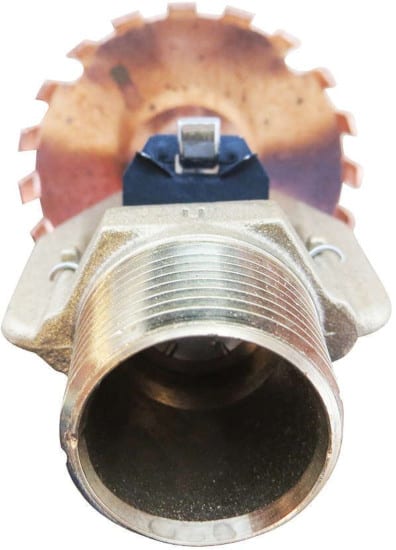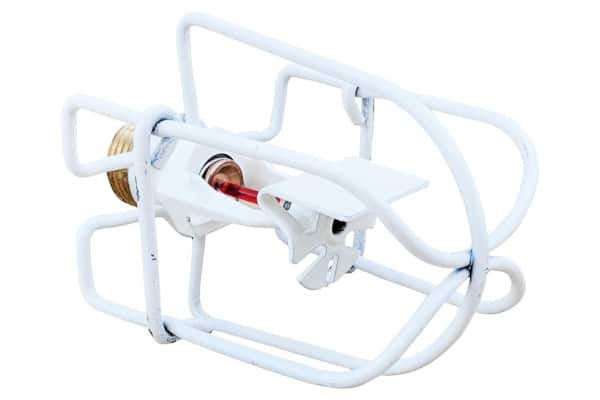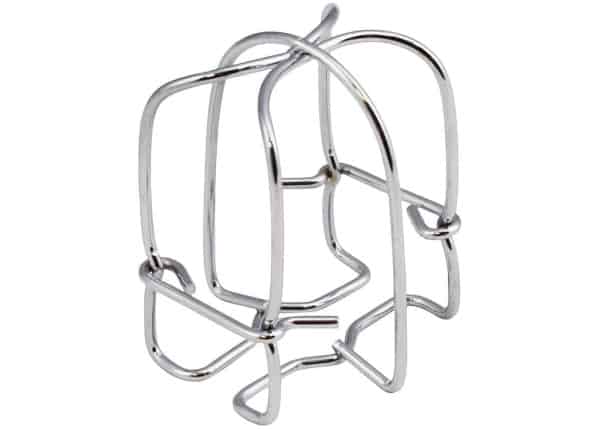3/4” fire sprinklers, found in warehouses and other industrial settings prone to high-challenge fires, may have a greater need for sprinkler head guards
Fire sprinkler system designers carefully consider a variety of factors before sourcing sprinkler heads, including temperature, response type, and orientation. Even escutcheons—the metallic fixtures in which some sprinkler heads sit—must meet specific design and installation criteria. It’s no surprise, then, that our customers aren’t always sure which sprinkler head guards they need to protect their sprinklers against impact. One question often arises: where are all the head guards for 3/4” fire sprinklers?
The short answer is that most fire sprinkler head guards—including those made by a manufacturer for their own catalog of sprinklers—will fit 3/4” heads. In this article, we explain what sets 3/4” sprinklers apart from their smaller (and more common) counterparts, why they are especially likely to need protection, and which fire sprinkler head guards can do the job.
If you’d like to purchase a head guard for your 3/4” sprinkler head now, you can browse our full selection of fire sprinkler head guards, including recessed, standard, and heavy-duty models.
What we call 1/2” and 3/4” fire sprinklers have either 1/2” or 3/4” thread connections
In the United States, most fire sprinklers are sold in one of two “sizes”: 1/2” (12.7 millimeters) and 3/4” (19.3 millimeters). While there are other sizes on the market—including 1” and even 1 1/4”—these two are far and away the most common. Here, 1/2” or 3/4” refers to the fire sprinkler’s thread connection, which is where the base of the sprinkler head joins with a pipe fitting to connect to a supply of water.
These thread connections conform to a standard called NPT (short for National Pipe Thread, National Pipe Taper, or American National Standard Taper Pipe Thread). This standard ensures compatibility and a secure seal between various NPT pipes and fittings, as well as sprinklers. From top to bottom, each 3/4” fire sprinkler’s thread connection has 14 threads, and those threads run at a 60-degree angle to the sprinkler head.
Note also that these sizes are nominal—meaning that they’re 1/2” or 3/4” in name only. The actual width of these threads won’t ever measure at 1/2” or 3/4”. However, a male NPT fitting and a female NPT fitting marked as the same size will always thread together successfully.

The design limitations of 1/2” models make 3/4” sprinkler heads the standard choice when more water is needed
In theory, there isn’t much of a difference between a 1/2” and a 3/4” fire sprinkler. After all, these sizes refer only to how the thread engages with the pipe. But a quarter-inch increase in exterior size has a substantial impact on how much more water can flow through the connection’s interior waterway.
A fire sprinkler’s K-factor represents how quickly the head can flow water. It’s often expressed as a whole number and decimal paired with the letter “K” (e.g. 5.6K, 8.0K, and so on), and increases with the fire sprinkler’s orifice size. Heads with these larger K-factors can produce larger, faster-moving droplets designed to fight more challenging fires.
Many American states and cities base their fire codes on NFPA 13: Standard for the Installation of Sprinkler Systems. For commercial or industrial buildings in these jurisdictions, the minimum acceptable K-factor for a fire sprinkler is 5.6K.
NFPA 13 makes some exceptions for settings with especially low fire risk (“light hazard occupancies”) and some types of dry-pipe, preaction, and exposure-protection systems. But K-factors smaller than 5.6K are largely seen in residential fire sprinkler systems. Across the board, sprinklers with these orifices—from the standard 5.6K size to some small-orifice sprinklers—have 1/2” NPT threads.

In some settings where larger droplets and faster-moving water are needed, however, a sprinkler with a larger K Factor (such as 8.0K) is needed. And this scenario is what usually calls for a fire sprinkler with a 3/4” connection.
Newly installed fire sprinkler systems that comply with NFPA 13 may not use 1/2” sprinklers with orifice sizes greater than 5.6K. Some manufacturers sell 8.0K heads with 1/2” thread connections, but only for replacement of existing sprinkler heads.
The 2003 edition of Operation of Fire Protection Systems—also published by the National Fire Protection Association—remarks that these restrictions came about because of problems “flowing large quantities of water through a relatively small opening.” In practice, what this means is that 3/4” fire sprinklers are chosen in new systems where flow rates greater than 5.6K are needed.
These “cages” are usually needed in the high-risk environments where 3/4” sprinkler heads are installed
Larger orifices (and with them, larger thread sizes) are common in warehouses and in other locations with greater fire risks. After 5.6K, 8.0K is the next largest standard size. But with higher-stacked and more densely packed storage, installers have increasingly turned to sprinklers with even larger K-factors. These larger orifice sizes allow installers to double, triple, or even quadruple the volume of water discharged by a single sprinkler head.
3/4” fire sprinklers may have a variety of K-factors, including:
- 0K (40% water increase over 5.6K)
- 2K (100% over 5.6K)
- 0K (150% over 5.6K)
- 8K (200% over 5.6K)
And facilities that need more water are often the same environments where fire sprinklers are broken by mechanical impact. Construction workers may accidentally break a head in the course of constructing or renovating a building. Machinery or tools can easily collide with a sprinkler head, damaging inventory and shutting business down until cleanup and sprinkler replacement are completed.
Buildings with higher-than-average fire risks may also be at greater risk of losing a sprinkler head to accidental activation. In these situations, fire sprinkler head guards can provide a protective membrane around sprinklers’ most fragile components. While most standard head guards won’t survive a direct impact with industrial equipment (or even a basketball), they can provide a visual warning—and a limited measure of protection—when people work near sprinklers.
Most of these fire sprinkler head guards consist of finished metal wire that pinches the sprinkler’s thread connection. Nearly all fit both 1/2” and 3/4” fire sprinklers. The limiting factor—especially for 3/4” sprinkler heads—is height. 3/4” sprinkler stand slightly taller than 1/2” models, meaning that a guard that grips the base securely may not leave enough clearance for the entire frame.

Listings, the level of protection needed, and other concerns should be considered before selecting a 3/4” fire sprinkler head guard
Where impacts are likely, NFPA 13 explicitly requires head guards:
From the 2019 edition of NFPA 13
16.2.6 Sprinklers subject to mechanical injury shall be protected with listed guards.
One key term in this requirement is listed—meaning tested and/or evaluated by third-party organizations for compatibility with specific sprinklers. Not all fire sprinkler head guards are listed. And for the most part, listed guards are manufacturer-specific: Tyco, Victaulic, or another manufacturer will offer head guards listed only with their own line of sprinklers.
There are also generic head guards, which aren’t made by the sprinkler’s manufacturer. These fire sprinkler head guards are sometimes listed. When they aren’t, contractors may be able to use them so long as local code officials (the authority having jurisdiction, or AHJ) permit it. Many generic head guards provide protection comparable to their listed counterparts at a lower cost.
Other types—specifically, heavy-duty head guards—provide a substantially different level of protection. These guards use larger mild-steel materials to provide a “crush zone” around a fire sprinkler head. Each guard secures directly to sprinkler piping, providing enough clearance for sprinkler heads and conventional head guards. These guards aren’t listed, so be sure to consult with your local fire marshal or code authority before installing (even temporarily).

The majority of 3/4” sprinkler heads can be fitted with either a manufacturer-specific head guard or a generic alternative. Be advised, though: Viking’s new line of XT1 fire sprinklers shouldn’t be installed with generic guards. While they’re shorter than many other models—and should, in theory, sit inside generic head guards with little trouble—the plugs that eject when these sprinklers activate have a small hinge. That hinge may get caught between the frame and the head guard when using a generic fire sprinkler head guard. As a result, purchasers should choose one of Viking’s manufacturer-specific head guards when installing XT1 fire sprinklers.
3/4” fire sprinkler head guards are easy to purchase and install—and they’re an important accessory in industrial or fire-prone settings
Standard fire sprinkler head guards can’t withstand most direct impacts from very heavy or fast-moving objects. But they’re a cost-effective way to lower the odds that an environment will flood and, worse, be left temporarily at risk of fire. And heavy-duty models may be able to weather harder hits.
Sourcing fire protection components can sometimes be complicated, but choosing a head guard requires answering only two questions: will it fit (in most instances, yes) and will my AHJ (often, the local fire marshal) allow it to be installed?
If you’re searching for a 3/4” fire sprinkler head guard, QRFS has a selection of standard head guards for pendent and horizontal sidewall sprinklers—whether they rest flush with the wall or ceiling or sit slightly within it. We also have heavy-duty models for exposed sprinklers. Our catalog includes:
- Standard head guards
- Recessed head guards
- Baffled head guards for storage sprinklers
- Heavy-duty head guards
If you’re searching for these guards after an accidental sprinkler activation, we also invite you to take a look at our selection of replacement 3/4” fire sprinklers. And if you’d like to be prepared for an accidental sprinkler activation, check out our inventory of Shutguns for pendent, concealed, sheared off, and institutional sprinklers. This handy tool quickly stops a fire sprinkler from spraying and even serves as a temporary sprinkler until the head is replaced.
Reach out to us with your questions or for help finding an item: call us at +1 (888) 361-6662 or email support@qrfs.com.
This blog was originally posted at blog.qrfs.com. If this article helped you, check us out at Facebook.com/QuickResponseFireSupply or on Twitter @QuickResponseFS.


